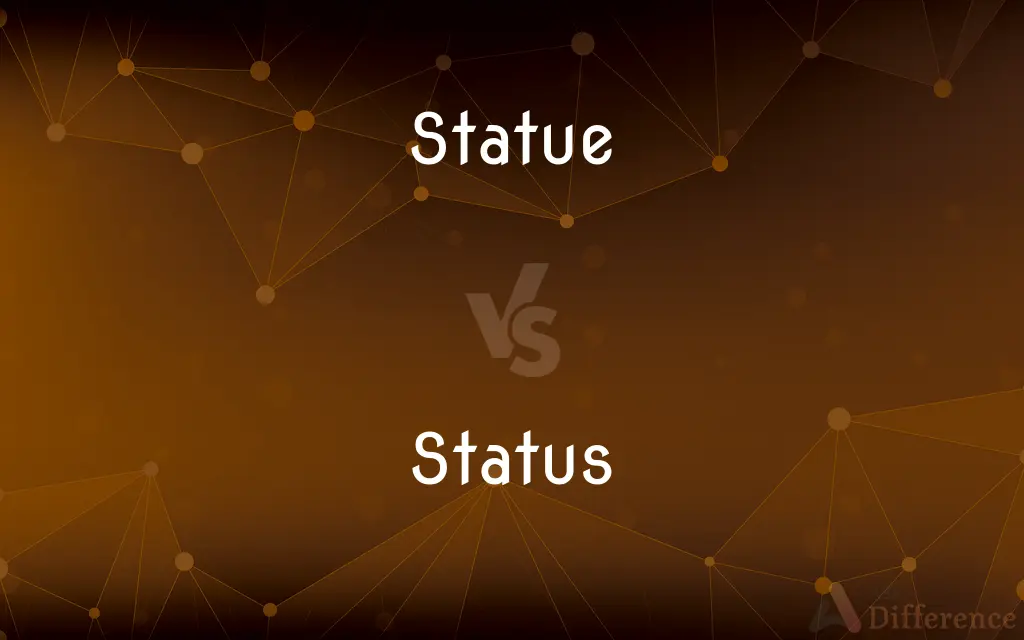Statue vs. Status — What's the Difference?
Edited by Tayyaba Rehman — By Fiza Rafique — Updated on April 5, 2024
A statue is a three-dimensional sculpture representing a figure, while status denotes a person's or thing's condition or position in relation to others.

Difference Between Statue and Status
Table of Contents
ADVERTISEMENT
Key Differences
A statue is primarily a physical representation, often crafted from materials like stone, metal, or wood, depicting people, animals, or mythical figures. This form of art has been used throughout history to immortalize individuals, symbolize ideas, or convey stories. On the other hand, status refers to the relative social, professional, or other standings of someone or something. It is an abstract concept that can change over time based on actions, achievements, or societal changes.
Statues are tangible and occupy physical space, serving as visual and historical landmarks in public squares, gardens, and museums. They are created through artistic processes involving sculpting, casting, or carving. In contrast, status is intangible, often determined by societal norms, personal achievements, or affiliations, and can be represented through titles, roles, or possessions.
While the creation of a statue involves artistic expression, craftsmanship, and physical labor, achieving or altering one's status often requires effort in social, educational, or professional realms. Whereas a statue's value might increase over time due to historical significance or artistic merit, a person's or entity's status can fluctuate based on performance, perception, or societal values.
Statues can be preserved, restored, or even replicated, allowing them to last for centuries and beyond, providing a physical link to the past. Status, however, is ephemeral and can change with the individual's circumstances, societal shifts, or through deliberate effort to improve or degrade one's standing.
Statues communicate through visual means, often requiring viewers to interpret their symbolism, artistic style, or historical context. Status, however, is communicated through social signals, language, behavior, or symbols of wealth and power, which can be more directly understood within a cultural context.
ADVERTISEMENT
Comparison Chart
Nature
Tangible, physical object
Intangible, conceptual
Representation
Artistic depiction of figures
Social or professional standing
Materiality
Made of materials like stone, metal, wood
Manifested through societal recognition
Changeability
Physically stable; changes with restoration or damage
Fluid, changes with achievements or societal shifts
Communication
Through visual symbolism and historical context
Through social signals, language, behavior
Compare with Definitions
Statue
A sculpture representing a person or animal.
The Statue of Liberty is a symbol of freedom and democracy.
Status
The condition or position of an individual or entity in relation to others.
The CEO's status in the company is unrivaled.
Statue
An artistic work created by sculpting.
Michelangelo's David is a renowned statue from the Renaissance.
Status
A social or professional rank or position.
Her status as a leading scientist is well-deserved.
Statue
A figure carved or cast in three dimensions.
The garden features a statue of a Greek goddess.
Status
The state of affairs at a specific time.
The project's status is ahead of schedule.
Statue
A monument made to commemorate a figure or event.
The city erected a statue to honor the local hero.
Status
A designation reflecting one's standing or importance.
The diplomat enjoyed status at international meetings.
Statue
A decorative or symbolic object in public spaces.
The central park's new statue has become a popular meeting spot.
Status
The level of respect or esteem attached to a position or person.
Authors often gain status from widespread recognition.
Statue
A statue is a free-standing sculpture in which the realistic, full-length figures of persons or animals or non-representational forms are carved or cast in a durable material such as wood, metal or stone. Typical statues are life-sized or close to life-size; a sculpture that represents persons or animals in full figure but that is small enough to lift and carry is a statuette or figurine, whilst one more than twice life-size is a colossal statue.Statues have been produced in many cultures from prehistory to the present; the oldest-known statue dating to about 30,000 years ago.
Status
Relative social or professional position; standing
An improvement in the status of women
Statue
A carved or cast figure of a person or animal, especially one that is life-size or larger.
Status
The situation at a particular time during a process
An update on the status of the bill
Statue
A three-dimensional form or likeness sculpted, modeled, carved, or cast in material such as stone, clay, wood, or bronze.
Status
Position relative to that of others; standing
Her status is that of a guest.
Statue
A three-dimensional work of art, usually representing a person or animal, usually created by sculpting, carving, molding, or casting.
Status
High standing; prestige
A position of status in the community.
Statue
(dated) A portrait.
Status
(Law) The legal character or condition of a person or thing
The status of a minor.
Statue
(transitive) To form a statue of; to make into a statue.
Status
The state of affairs; the situation
What is the status of the negotiations?.
Statue
The likeness of a living being sculptured or modeled in some solid substance, as marble, bronze, or wax; an image; as, a statue of Hercules, or of a lion.
I will raise her statue in pure gold.
Status
A person’s condition, position or standing relative to that of others.
Superstition is highly correlated with economic status.
Statue
A portrait.
Status
Or high standing.
Statue
To place, as a statue; to form a statue of; to make into a statue.
Status
A situation or state of affairs.
What's the status of the investigation?
New York is known for its status as a financial center.
Statue
A sculpture representing a human or animal
Status
(legal) The legal condition of a person or thing.
Status
The state (of a Canadian First Nations person) of being registered under the Indian Act.
He is a status Indian.
Status
(social networking) A function of some instant messaging applications, whereby a user may post a message that appears automatically to other users, if they attempt to make contact.
I'm just about to update my status to "busy".
Status
(medicine) Short for status asthmaticus.}}
Status
State; condition; position of affairs.
Status
The relative position or standing of things or especially persons in a society;
He had the status of a minor
The novel attained the status of a classic
Atheists do not enjoy a favorable position in American life
Status
A state at a particular time;
A condition (or state) of disrepair
The current status of the arms negotiations
Common Curiosities
What does status mean?
Status refers to the condition, position, or rank of a person or thing in comparison to others.
How can someone's status change?
A person's status can change through achievements, social recognition, or changes in societal or personal circumstances.
How are statues made?
Statues are made through processes like sculpting, casting, or carving, using materials such as stone, metal, or wood.
What is a statue?
A statue is a three-dimensional sculpture representing a person, animal, or object.
Do statues serve a purpose beyond decoration?
Yes, statues can serve as historical markers, symbols of cultural values, or memorials for significant individuals or events.
Can status be inherited?
Yes, status can be inherited through family lineage or social position, but it can also be achieved through personal efforts.
Are all statues made to commemorate someone?
Not all statues are commemorative; some may be purely decorative or artistic.
Is status the same as popularity?
Not exactly; while popularity can influence status, status is broader, encompassing social, professional, and personal standings.
Does everyone have a status?
Yes, everyone has a status, which can vary in different social, professional, or cultural contexts.
Can the significance of a statue change over time?
Yes, the significance of a statue can change due to shifts in cultural values, historical perspectives, or political contexts.
How do statues communicate?
Statues communicate through their form, symbolism, and placement, conveying messages or values without words.
What influences a person's status?
A person's status can be influenced by their achievements, social connections, wealth, and societal contributions.
Why are statues important in society?
Statues are important for commemorating historical figures, events, cultural values, and for their artistic contribution to public spaces.
Are statues considered art?
Yes, statues are considered a form of art that involves creativity, skill, and expression.
Can status be negative?
Yes, status can be negative if it reflects poor standing, disrepute, or low esteem in a certain context.
Share Your Discovery

Previous Comparison
Histogram vs. Pictogram
Next Comparison
Microsporogenesis vs. MicrogametogenesisAuthor Spotlight
Written by
Fiza RafiqueFiza Rafique is a skilled content writer at AskDifference.com, where she meticulously refines and enhances written pieces. Drawing from her vast editorial expertise, Fiza ensures clarity, accuracy, and precision in every article. Passionate about language, she continually seeks to elevate the quality of content for readers worldwide.
Edited by
Tayyaba RehmanTayyaba Rehman is a distinguished writer, currently serving as a primary contributor to askdifference.com. As a researcher in semantics and etymology, Tayyaba's passion for the complexity of languages and their distinctions has found a perfect home on the platform. Tayyaba delves into the intricacies of language, distinguishing between commonly confused words and phrases, thereby providing clarity for readers worldwide.
















































